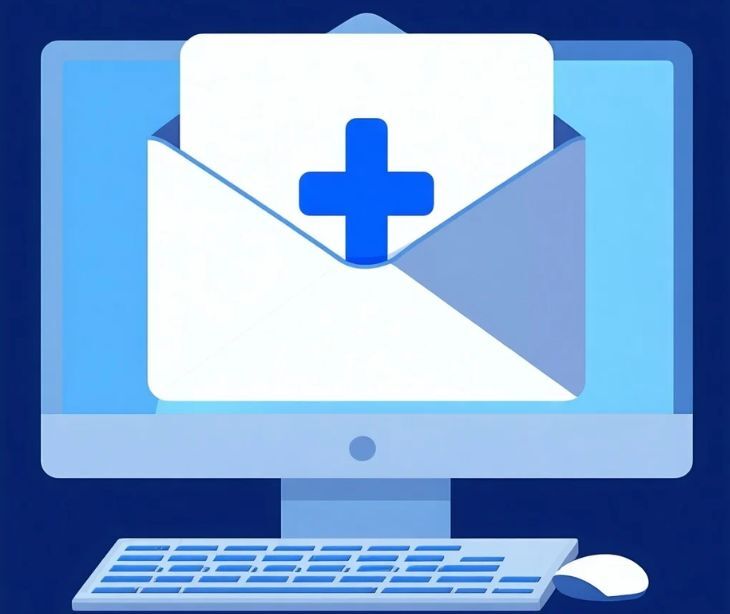7 min read
How healthcare organizations can implement HIPAA compliant email APIs
Lusanda Molefe May 28, 2025

A study published by Cambridge University Press reports that in 2021, over 319 billion business and consumer emails were sent and received daily worldwide, projected to grow to over 376 billion by 2025. Building on the global trend of increasing email traffic, healthcare providers have also adopted email as a key communication channel to deliver appointment reminders, lab results, billing information, and health education directly to patients. This widespread use shows the role of email in enhancing patient engagement and streamlining healthcare operations. At the same time, healthcare organizations must navigate ongoing challenges related to data privacy, security, and regulatory compliance, particularly given the sensitive nature of patient information.
Many healthcare organizations face significant challenges securing email communications, especially given the volume of phishing attacks and the need for proper email authentication (SPF, DKIM, DMARC) implementation, according to a 2024 HIMSS cybersecurity report. For example, only about 55% of healthcare organizations have properly implemented these protocols. This gap creates significant risk, HHS reported over 80 breaches last year involving unsecured email transmissions, potentially resulting in $9.77 million per incident according to IBM’s 2024 Cost of Data Breach Report.
Read more: Implementing DMARC for healthcare email security
Securing healthcare email authentication with DKIM
A guide to SPF in healthcare email security
What makes an email API HIPAA-ready?
It’s important to understand that “HIPAA compliant" isn't a certification an email API can earn. Instead, it refers to an email API service provider that has implemented specific features and is willing to enter into the necessary legal agreements, thereby enabling you to use their service in a HIPAA compliant manner. These aren't just general good security practices, they are safeguards mandated by HIPAA's Security Rule to ensure the confidentiality, integrity, and availability of protected health information (PHI).
- Business associate agreement (BAA): Any vendor that handles PHI on your behalf must be willing to sign a BAA. This legally binding contract obligates them to protect PHI according to HIPAA rules, outlining their responsibilities and liabilities. Without a signed BAA, you cannot compliantly use an API to transmit PHI. Lee Kim, senior principal at HIMSS states, “Data breaches involving third-party software and third-party service providers are getting more prevalent since more organizations (within and outside of healthcare) are relying on third-party service providers and third-party software.”
- Strong encryption (In transit and at rest): All email transmissions facilitated by the API must use encryption protocols, with TLS 1.2+ being the mandatory minimum for data in transit. Furthermore, any PHI temporarily stored at rest on the vendor's infrastructure must also be protected with strong encryption, such as AES-256.
- Access controls and authentication: The API service must implement measures to control access to its platform and API endpoints. This includes requiring unique user IDs and strong authentication mechanisms for all API calls to prevent unauthorized access.
- Audit trails and logging: For accountability and breach investigation purposes, the service must provide detailed, immutable logs of all API calls and email sending activities. These logs are necessary for demonstrating compliance and for forensic analysis in the event of a security incident.
- Secure infrastructure: The vendor must maintain a secure operational environment. This is often demonstrated through independent audits or certifications like SOC 2 Type 2 or HITRUST CSF, which validate their commitment to data security and privacy.
- Clear PHI handling policies: The vendor must explicitly guarantee that they will not use or disclose PHI for any unauthorized purposes, ensuring that patient data remains confidential and is only processed as necessary for the agreed-upon services.
Compliant use cases
Once a HIPAA-ready email API is in place, it can enhance various aspects of patient communication, adding substantial value while maintaining compliance. The use of APIs in healthcare, as mentioned in a study published in Context Sensitive Health Informatics: Sustainability in Dynamic Ecosystems, is seen as key to the sustainability of applied clinical informatics research, as well as associated improvements in patient engagement, clinical decision making, efficiency, quality, and safety of the healthcare delivery system. These benefits are realized through practical applications such as:
- Appointment reminders: Sending automated reminders to reduce costly no-shows and improve clinic efficiency.
- Patient portal notifications: Securely alerting patients to check their patient portal for new messages, test results, or updates. The email itself should not contain PHI, it should only serve as a notification to log into a secure portal.
- Post-visit summaries and education: Delivering follow-up instructions, educational materials, or post-operative care guides. These are often sent via secure links or encrypted attachments to safeguard PHI.
- Care coordination: Securely notifying different providers involved in a patient's care (with appropriate patient consent or authorization) to ensure seamless transitions and continuity of care.
- Telehealth support: Sending secure links and detailed instructions for virtual appointments, ensuring patients can easily access their telehealth sessions.
- Billing and administrative updates: Securely transmitting invoices, payment reminders, or other administrative communications related to patient accounts.
- Health alerts and feedback: Sending general health alerts or collecting patient feedback through secure forms linked within emails, without directly exposing PHI.
A step-by-step approach
Implementing a HIPAA compliant email API requires careful planning and execution to ensure a secure and compliant integration:
Step 1: Vendor selection and due diligence
Begin by thoroughly researching providers who explicitly market and offer HIPAA-ready email API services. Do not assume compliance; verify it.
- Verify BAA willingness: This is non-negotiable. Confirm the vendor is willing to sign a comprehensive BAA that meets your organization's legal requirements.
- Review security documentation: Request and scrutinize their security policies, certifications (especially HITRUST), and detailed descriptions of their encryption standards (in transit and at rest), access controls, and data handling procedures.
- Assess API documentation and support: Evaluate the clarity and completeness of their API documentation. Look for developer support resources, as you’ll rely on them during integration.
Step 2: Sign the BAA
This step cannot be overstressed. Do not transmit any PHI using the API until a fully executed BAA is in place between your organization and the email API vendor. This legal agreement is the foundation of your HIPAA compliance regarding their service.
Step 3: Secure integration
Once the BAA is signed, focus on securing your technical integration.
- Securely manage API keys and credentials: Treat API keys as highly sensitive passwords. Implement strict access controls, avoid hardcoding them, and use environment variables or secure vault services for storage. Rotate them regularly.
- Implement API according to best practices: Follow the vendor's recommended best practices for API authentication and usage. This often includes using secure protocols (HTTPS), strong authentication tokens, and rate limiting.
- Configure email authentication: Properly set up email authentication records for your sending domain, including SPF, DKIM, and DMARC. This helps prevent email spoofing and improves deliverability while adding a layer of trust.
Step 4: Crafting compliant content and workflows
The content of your emails and the workflows surrounding them are important for compliance:
- Apply "minimum necessary" principle: When PHI must be included in an email, only send the absolute minimum amount of information required to achieve the communication's purpose.
- Prioritize secure portals: For sensitive PHI, such as diagnoses, full test results, or detailed treatment plans, the best practice is to use the API-sent email only as a notification. The email should direct the patient to log into a secure patient portal where they can access the sensitive information. This significantly reduces the risk of PHI exposure if an email account is compromised.
- Consider encryption options: If sending PHI directly via email is unavoidable and authorized by patient consent (or other HIPAA provisions), understand the API's capabilities. Does it enforce TLS for all transmissions? Does it offer message-level encryption or a secure web portal fallback for recipients whose email providers don't support encryption?
- Avoid PHI in subject lines: Subject lines are generally less secure and more visible to intermediaries and less secure email clients. Never include PHI in email subject lines.
Step 5: Managing patient consent
Patient consent is a cornerstone of HIPAA compliance for electronic communications.
- Develop a clear consent process: Establish a clear, documented process for obtaining and recording patient consent for receiving electronic communications, especially those that might contain or link to PHI. This often involves a patient authorization form.
- Inform patients about risks: As per HHS guidance, clearly inform patients about how their information will be sent electronically and any associated risks (e.g., while you use secure methods, the recipient's email provider might not, or their device could be compromised).
- Provide opt-out mechanism: Offer an easy and clear method for patients to opt-out of electronic communications or update their preferences at any time.
Step 6: Monitoring and auditing
- Regularly use logging features: Leverage the API's logging and reporting features to routinely review sent emails, delivery statuses, and any errors.
- Monitor for issues: Keep an eye out for delivery issues, bounces, or potential security alerts generated by the API vendor.
- Be prepared for audits: Maintain thorough records and be prepared to provide audit logs and documentation of your secure email communication processes if requested for compliance checks by regulators or auditors.
Paubox Email API
When evaluating HIPAA compliant email API options, Paubox Email API stands out as a purpose-built solution for healthcare organizations. Designed specifically with HIPAA compliance in mind, it addresses the key requirements outlined above while simplifying the technical implementation process for healthcare developers and IT teams.
Key compliance features
Paubox Email API aligns with the HIPAA requirements discussed earlier by providing a comprehensive compliance foundation. The service is 100% HIPAA compliant and includes a BAA with every account, eliminating potential compliance obstacles. Security is ensured through TLS 1.2 or higher encryption for all messages, protecting PHI during transmission. Unlike many email solutions that require recipients to create accounts or click through portals, Paubox delivers encrypted emails directly to recipients' inboxes without additional steps, improving patient experience while maintaining security. The HITRUST CSF certification provides independent verification of their security controls, demonstrating their commitment to meeting healthcare's rigorous security requirements.
Real-world applications
- Test results: Automating secure updates to customers and internal teams on the status of test results.
- Appointment communications: Programmatically sending appointment confirmations and reminders to reduce costly no-shows.
- Referrals: Securely sending referrals with patient details to specialty offices, maintaining PHI protection throughout the process.
- Help desk communications: Enabling technical support teams to securely communicate with users while including necessary PHI.
As Morgan Smith, COO at Coral, explains: "Using Paubox Email API for our system notifications saves our customers time, saves them trouble, and gives them more information." Similarly, Tyler Laracuente, CTO at Rollover Rep, notes, "The ease of implementation was really, really helpful. And is still helpful today because we were able to prototype and release new features easily."
Implementation process
- Sign up and create a Paubox account: Getting started is free, allowing organizations to send up to 300 emails per month at no cost.
- Activate and verify your domain: This involves adding the domain you'll use for sending emails and verifying ownership through DNS records, including SPF configuration to ensure proper email authentication.
- Generate your API key: Once your domain is verified, you can generate API keys for different applications as needed.
- Integrate the API into your application: Using one of the ten available SDKs or the comprehensive API documentation, developers can quickly implement the solution with example code provided.
FAQs
What is an email API?
An Email API allows your software application to programmatically send, receive, or manage emails. It acts as a bridge for automated email communication, letting your systems send messages like appointment reminders without manual intervention.
What is the HIPAA Security Rule?
The HIPAA Security Rule sets national standards for protecting ePHI. It mandates administrative, physical, and technical safeguards for covered entities and their business associates to ensure the confidentiality, integrity, and availability of all ePHI, preventing unauthorized access or disclosure.
What is a patient authorization form?
A patient authorization form is a legal document signed by a patient that grants permission to a healthcare entity to use or disclose their PHI for specific purposes beyond standard treatment, payment, or healthcare operations. It ensures patients control how their health data is shared.
Subscribe to Paubox Weekly
Every Friday we'll bring you the most important news from Paubox. Our aim is to make you smarter, faster.




